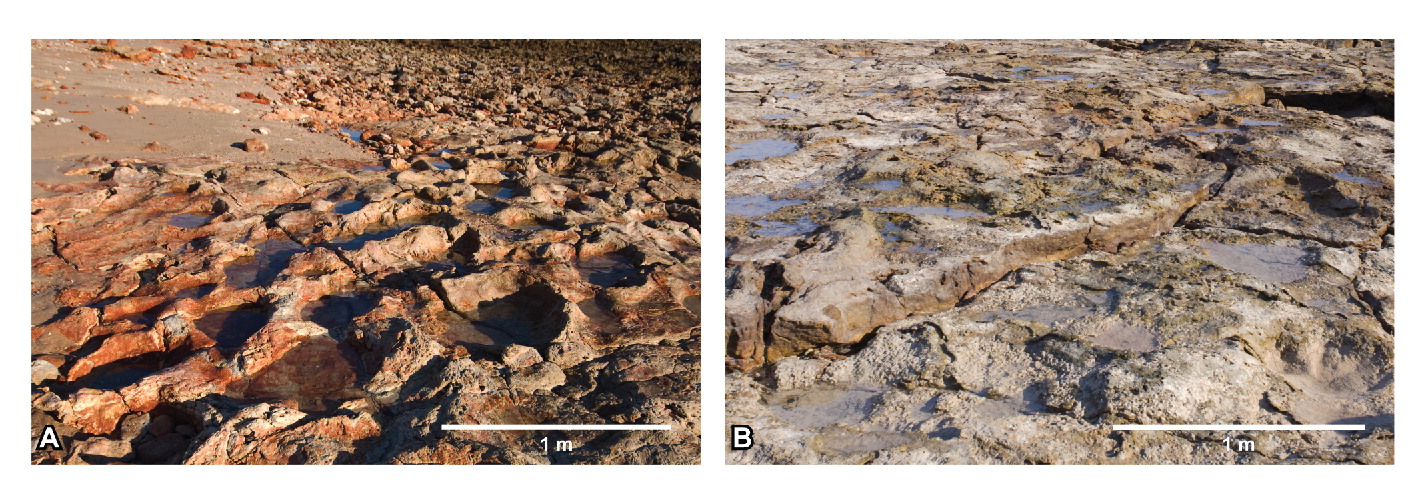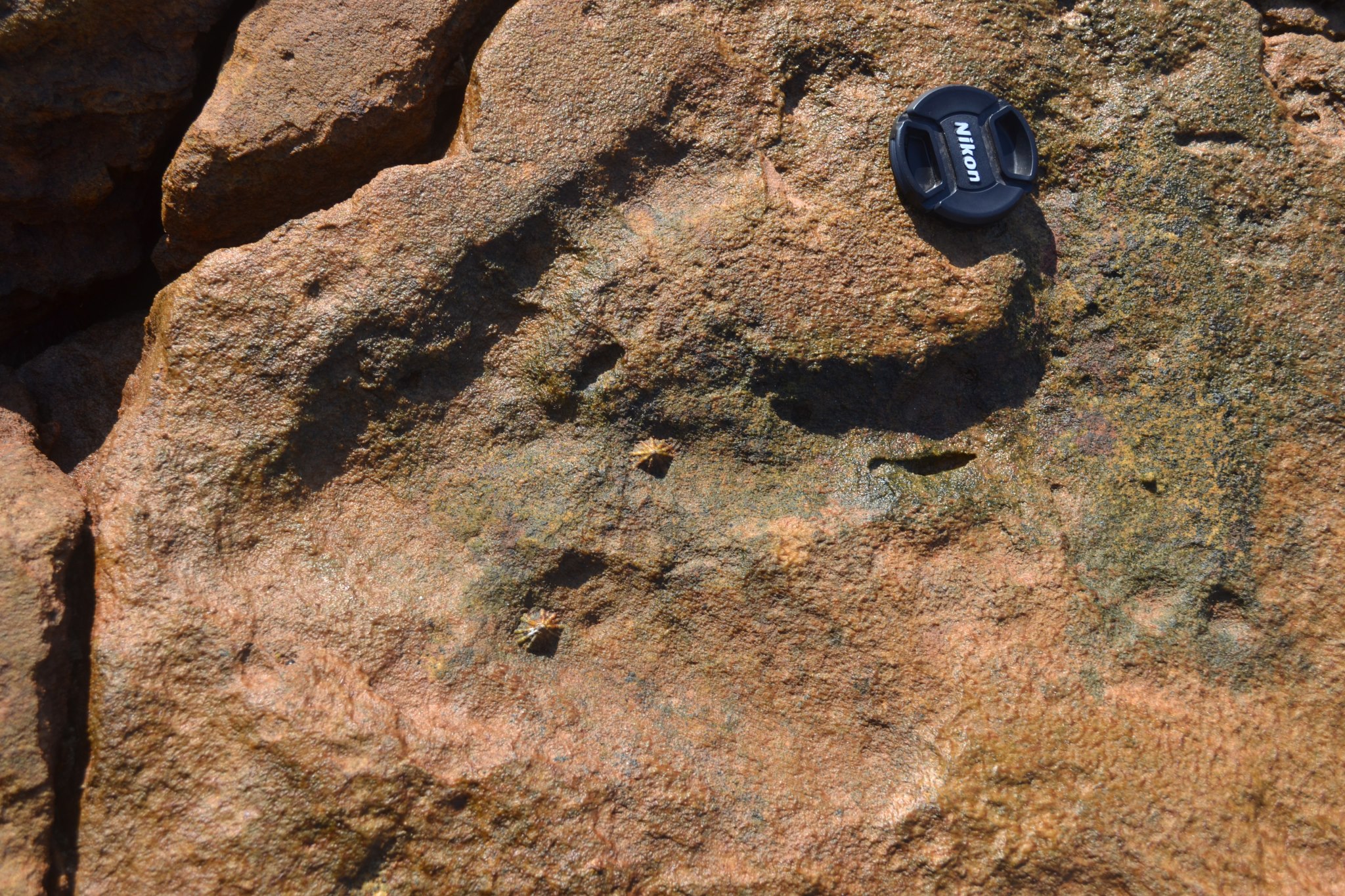Stellenbosch University Sedimentologist helps to contextualize dinosaurian trace fossils along the Western Coast of Australia (Broome, Western Australia)
Video link: https://vimeo.com/210176160
As far back as the 1960's, supposed dinosaur tracks were described near to the well known Western Australian town of Broome (identified as Megalosauropus broomensis, a medium-sized theropod trackmaker) Brief reports in the early 1990s suggested the occurrence of at least another nine types of tracks, referable to theropod, sauropod, ornithopod, and thyreophoran trackmakers, at scattered tracksites spread over more than 80 km of coastline north of Broome, potentially representing one of the world's most diverse dinosaurian ichnofaunas. Yet, it was only due to recent efforts by palaeontology crews from The University of Queensland and James Cook University (now Dept. of Earth Sciences, Stellenbosch University) that scientists have uncovered the astounding diversity of trackmakers, estimated to be about 16, which are spread over more than 200 km along the Dampier Peninsula. These Dinosaur traces are preserved within the coastally exposed Lower Cretaceous (Valanginian–Barremian) Broome Sandstone, and currently, provides nearly the only fossil record of dinosaurs from the western half of the Australian continent. At the request of the area's Goolarabooloo Traditional Custodians, Dr. Steve W. Salisbury (UQ) and crew conducted 400+ hours of ichnological survey work was undertaken from 2011 to 2016 on the 25 km stretch of coastline in the Yanijarri–Lurujarri section of the Dampier Peninsula, inclusive of the coastline at Walmadany (James Price Point).

Picture: Exposures of Broome Sandstone preserving evidence of heavy 'dinoturbation.' A, UQL-DP30, showing a likely sauropod thoroughfare; B, UQL-DP9, showing partly eroded tracks of large ornithopods and sauropods. (Image within Salisbury et al., 2016)
Forty-eight discrete dinosaurian tracksites were identified in this area, and thousands of tracks were examined and measured in situ and using three-dimensional photogrammetry. Tracksites were concentrated in three main areas along the coast: Yanijarri in the north, Walmadany in the middle, and Kardilakan–Jajal Buru in the south. Dr. Ryan Tucker, conducted a sedimentology and taphonomic investigation to better understand the habitat the dinosaurs were utilizing, and just how such an extensive array of tracks were preserved. By identifying clues left in the rock Dr. Tucker was able to identify 16 repeated facies types that occurred in three distinctive lithofacies associations, which indicated these dinosaurs were living in a distal fluvial to deltaic portion of a large braid plain migrating sand bodies and periodic sheet floods. The main dinosaurian track-bearing horizons seem to have been generated between periodic sheet floods that blanketed the preexisting sand bodies within the braid plain portion of a tidally influenced delta, with much of the original, gently undulating topography now preserved over large expanses of the present day intertidal reef system.

Preserved theropod ichnite in the Broome Sandstone, near to Broome, Western Australia.
Dr. Salisbury and Dr. Romolio estimate that of the tracks examined, 150 could be identified and are assignable to a least eleven and possibly as many as 21 different track types: five different types of theropod tracks, at least six types of sauropod tracks, four types of ornithopod tracks, and six types of thyreophoran tracks. Eleven of these track types can formally be assigned or compared to existing or new ichnotaxa, whereas the remaining ten represent morphotypes that, although distinct, are currently too poorly represented to confidently assign to existing or new ichnotaxa. The overall diversity of the dinosaurian ichnofauna of the Broome Sandstone in the Yanijarri–Lurujarri section of the Dampier Peninsula is unparalleled in Australia, and even globally. In addition to being the primary record of non-avian dinosaurs in the western half of Australia, this ichnofauna provides our only detailed glimpse of Australia's dinosaurian fauna during the first half of the Early Cretaceous. The full extent and nature of the Dampier Peninsula's dinosaurian tracksites yet to be adequately addressed, the overall scientific significance of the ichnofauna has remained enigmatic. To read more, please see the fully published annual memoir in the Journal of Vertebrate Paleontology (http://www.tandfonline.com/doi/full/10.1080/02724634.2016.1269539)
Title pictures:
Picture Main: Walmadany (James Price Point) famed pindan cliffs with coastal exposure of the Lower Cretaceous (Valanginian–Barremian) Broome Sandstone
Picture left: Distribution of trackmakers: Diversity of dinosaurian ichnospecies/track morphotypes specific to the Kardilakan–Jajal Buru, Walmadany, and Yanijarri sections of the Dampier Peninsula, Western Australia. Silhouettes denote inferred trackmaker ichnotaxa, of which there are 13 different types at Kardilakan–Jajal Buru, 11 at Walmandany, and eight at Yanijarri. See publication for further details (Salisbury et al., 2016)

